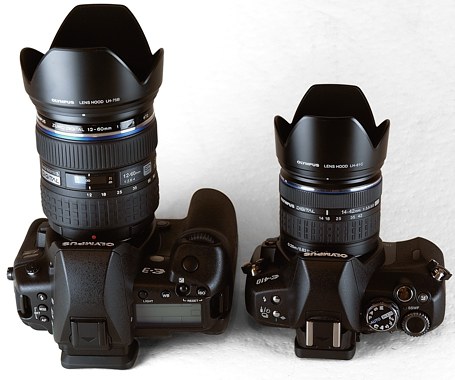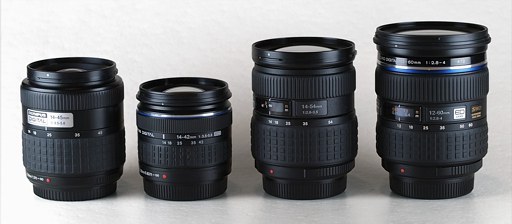2007 was a good year for the Olympus SLR system. The E-500, more successful on the market than any previous model, was replaced with the all-new E-410 and E-510, which, with (almost) all features just right, established Olympus as a solid (if not dominant) player in the sub-$1000 digital SLR field.

2007: from the E-410 to the E-3
(Image shot with the E-510 and the 50 mm F/2 Macro ZD lens)
A risky step, but more successful than I ever expected. And yes, from what I know these models are selling even better than the E-500 was.
Then we have seen, at long last, the introduction of the "professional" E-3. I have mixed feelings for this camera: on one hand it has impeccable build quality, a delightful viewfinder, and delivers outstanding images (in right hands, as always); on the other, many of us will not be happy with the external controls: not matching the E-1, not to mention the E-10/E-20. Without going into details (provided by everybody and his mother in many available reviews), I may only say that the camera does not have this just-perfect feeling as soon as you take it in your hands; this impressions gets only stronger when you start actually using it. Certainly, after gaining some familiarity with the E-3 you'll be using it just fine — but something is missing, at least from where I stand.
(For more on the E-3, see the Four Thirds section of this site: my First Look as well as a detailed Review and Reference.)
But what I am missing even more, is that the E-3 does not offer some features which would make it stand out from the crowd (which includes, notably, the Canon 40D and Nikon D300). The competition already has a dust removal system and Live View (if without tilting monitor), and we have learned to expect something like that from Olympus. Well, maybe with the new imaging engine firmly in place, this is what we will see in this coming year?
In 2008 the competition on the digital SLR market will remain fierce; actually, I expect it to intensify. This market consists of three major, overlapping, segments: entry-level, enthusiast, and upper level (professional, advanced amateur).
On the first level, the E-510 and E-410 are doing just fine. As the mass market demands a new model every year, Olympus will probably offer updated versions of these models, just to keep the "latest, greatest" image. I only hope they will not be re-designing everything from the ground up again; this may be the time to clip coupons off the R&D and all machining investment. Well, maybe a new version of the imager, some tweaks in the processing engine, some cosmetic improvements — but these cameras, or their improved versions, should take care of this segment for the next year.
Indeed, the E-520 and E-420 were relatively small, incremental updates to these models, aimed at the same market and not breaking any new barriers.
The top level offering, the E-3, will, I would expect, remain unchanged. The E-3 was just too much of an investment to replace with something else right away; besides, that's not where most of the money is. It may not bring many new converts to the camp (like the E-1 did), but it will certainly satisfy those who need a pro-level body to use with the Zuiko Digital glass.
Where I would expect some real new developments this year is the middle (enthusiast) segment of the market. What I believe this segment needs is a new, mid-line SLR model, filling the gap between the E-510 and E-3.
What may such a model need to make it an alternative to those two? Here is my personal list:
- A solid, relatively compact body, perhaps 5-8% or so smaller than the E-3, which would result in a 15-25% reduction of volume and weight. The body below 625 g (700 g with battery) would be close to perfect; the extra 150 g over the E-510 leaves room for the better viewfinder and, perhaps, a bit robust body (no weatherproofing, though; something at the level of the E-300).
- A pentaprism viewfinder with at least 95% (linear) coverage and 1.0× magnification. While this would not be a match for the E-3 (100%, 1.15×). it would help a lot. For me at least, a better viewfinder is worth an extra $200 added to the E-510 price, and it would be the most significant improvement over that model.
- A tiltable monitor, to take full advantage of the Live View. It does not really need two degrees of freedom; one (like, say, in the E-10 or C-5050Z) would be enough; if two, however, then an in-line solution like in the E-330 might be preferable to the flip-out one used in the E-3.
- Controls based on the E-510, with incremental improvements (exposure bracketing as one of drive modes, minor tweaks to the Control Panel, streamlining of the menu system).
- Imaging engine "trickled down" from the E-3, where economically feasible; perhaps a resolution increase to 12 MP (if mostly to keep the specs-driven market happy).
All this would be already enough to put me in line for an upgrade from the E-510. The new camera would still, however, miss a major feature differentiating it from others on the market. While it is difficult to tell what that may be, here are some suggestions (as opposed to the wish list above):
- Removable anti-aliasing filter (like in Sigma SD-14?), dramatically improving exposure in infrared shooting (a factor of 1000× or so), but also adding to the resolution (at the expense of color rendition, at least under some circumstances). This might, however, be in the science-fiction realm, as that filter is, I believe, also used as a part of the anti-dust system. Still, such a feature would make the new camera a must-have for some photographers.
- A wireless interface for an external, hand-held exposure meter. Such a meter (including incident light capability) could then provide exposure and color accuracy/reproducibility way beyond any through-the-lens system. While this is a feature more fitting on a pro model, introducing it in a mid-line one could make sense, keeping the brand ahead of the competition.
I guess most of the Readers could add some items to both lists above; the first one, however, seems to be difficult to argue with. In any case, in order to make the mid-line offering attractive, Olympus has to keep the good things from their economy line, borrow some more from the E-3 (just not the not-so-good stuff, please!), and throw in something new, making the camera different. What will that be? We will see.
The new E-30 is just about to show in stores. My expectations about body weight and size were (almost) met; those regarding the viewing system — slightly exceeded. Three remaining items on my wish list also found their way into the new model. On the flip side, the E-30 does not offer any new, revolutionary feature like the two examples I came up with above. Well, the digital level is new: nice, but not quite a big thing.
The cameras are not everything. A major strength of the Olympus SLR system is the lenses. While other manufacturers were, originally at least, depending on film legacy glass for their digital SLRs, Olympus dif not have that advantage (or, perhaps, a handicap?), and in the five last years has developed an impressive lens line. Most importantly, the less-than-premium Zuiko Digital glass may show limited specs, but no visible corner-cutting in the image quality department (see, for example, the "new kit" lenses: 14-42 and 40-150 mm ZD). And, in case you've been living under a rock for the last few months, the new 12-60 mm ZD is as close to a perfect general-use zoom as I can imagine. If I had to live with just one lens for my SLR system, it would be this one.
